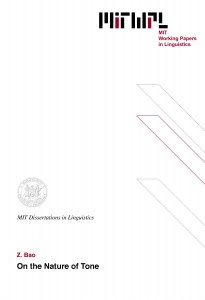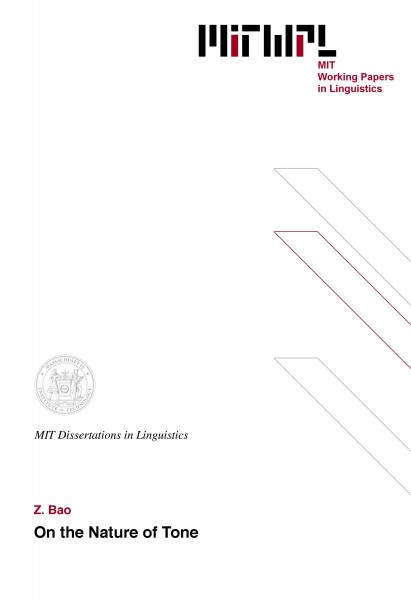On the Nature of Tone
Z. Bao, 1990
This Thesis addresses two issues: the feature geometry of tones; and the formal relation of tone with respect to other aspects of phonological representation.
The tonal geometry I propose can be stated simply: tone (t) consists of register (r) and contour (c):
(1) t (2) r c
/ \ | / \
r c [stiff] [aslack][bslack]
r is specified by the largyngeal feature [stiff], and c by the laryngeal feature [slack]. In addition, c is allowed to branch. The structures of r and c are in (2).
Since tone is phonetically executed by the VC node, it is claimed that the geometry of tone is a substructure of the geometry of laryngeal features. The geometry of laryngeal features is shown in (3) (CT=cricothyroid; VOC=vocalis):
(3) Laryngeal
Vocal Cords Glottal
CT VOC
| | [constricted glottis]
[stiff] [slack] [spread glottis]
It is speculated that register is executed by the articulator CT; and contour by the articulator VOC over time.
I argue against a tone plane. The mapping of tones to tone bearing units (TBU) is an adjunction process: tone is adjoined to the tone bearing unit. Given that the rime is the TBU, tone mapping creates the structure below:
(4) R’
|
R t
Thus, tones form a tier on the syllable plane, rather than an independent plane. This accounts for structure-dependency of tone stability.
After tone sandhi rules have applied, t is liked to the laryngea node of the head of TBU through the process of segmentalization. This allows tone to be phonetically realized on vowels or other segments which may be the head of tone bearing units.
Thesis Supervisor: Morris Halle
Title: Professor of Linguistics and Philosophy
Table of Contents
Chapter One An overview 7
1.1 The Geometry of Tone 7
1.2 Tone as Autosegmental Tier 11
Chapter Two Theories of Tone: A Survey 16
2.1 The Yin-Yang Registers 16
2.2 Chao (1930) 19
2.3 Wang (1967) 21
2.4 Woo (1969) 25
2.5 Yip (1980) 31
2.6 Clements (1983) 37
2.7 Hyman (1986) 42
2.8 Shih (1986) 44
2.9 Yip (1989) 47
2.10 Hyman (1989) 49
2.11 Halle and Stevens (1971) 53
Chapter Three The Representation of Tone 57
3.1 The Geometry of Tone 57
3.2 The Motivation of Underlying Contour 67
3.3 Assimilation in Tone Sandhi 69
3.3.1 Tone Assimilation 69
3.3.1.1 Danyang 69
3.3.1.2 Changzhi 83
3.3.2 Register Assimilation 88
3.3.3 Contour Assimilation 95
3.3.3.1 Zhenjiang 96
3.3.3.2 Wenzhou 105
3.3.4 Feature Assimilation 111
3.4 Contours and Other Matters 117
3.4.1 Distributional Properties of Tones 117
3.4.1.1 The Distribution of Even Tones 117
3.4.1.2 The Distribution of Falling/Rising Tones 122
3.4.2 Convex and Concave 125
3.4.2.1 Chanzhi 126
3.4.2.2 Xining 134
3.4.3 Contour Simplification 141
3.5 Tone and The Geometry of Laryngeal Features 148
3.6 Contour System versus Level System – a Parametric View 160
3.7 Some Problematic Consequences of the Theory 165
3.7.1 Syllable Nasals and Obstruents 166
3.7.2 Unusual Tonal Inventories 171
Chapter Four Autosegmental Nature of Tone 175
4.1 Tonal Morphemes 178
4.1.1 Danyang Word Melodies 178
4.1.2 Wenzhou Definitive Morpheme 180
4.1.3 Cantonese Changed Tones 182
4.1.4 Prefixes in Jiading Miao 194
4.2 Tone under Segmental Deletion 199
4.2.1 Cantonese 199
4.2.2 Fangqie Languages 204
4.3 The Bridge Effect 207
Chapter Five Tone in Phonological Representation 218
5.1 The Dual Nature of Tone 218
5.2 Structure-Dependency of Tone Stability 232
5.3 Segmentalization of Tone 245
5.4 Phonological Processes of Tone Sandhi 271
5.4.1 Assimilation 272
5.4.2 Dissimilation 280
5.4.3 Other Sandhi Processes 282
Chapter Six The Mid Tone 284
6.1 The Numerals 292
6.2 The Classifiers 298
6.3 R-Lowering Re-visited 305
Appendix 311

